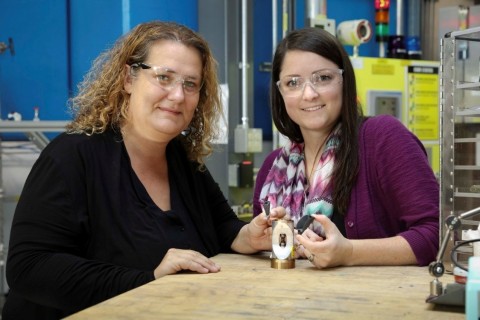- ExOne to commercialize production of parts 3D printed in aluminum-infiltrated boron carbide
- The functional 3D printed material has a wide range of potential applications
- ExOne to begin 3D printing collimators and other parts for ORNL in the new material
NORTH HUNTINGDON, Pa. — (BUSINESS WIRE) — August 19, 2019 — The ExOne Company (Nasdaq: XONE), the global leader in industrial sand and metal 3D printers using binder jetting technology, today announced it has licensed from the Department of Energy’s Oak Ridge National Laboratory (ORNL) a patent-pending method of 3D printing aluminum-infiltrated boron carbide (B4C) collimators and other components used in neutron imaging.
This press release features multimedia. View the full release here: https://www.businesswire.com/news/home/20190819005143/en/

Pictured are Bianca Haberl (left) and Amy Elliott, both of ORNL. Haberl is a neutron scattering scientist, while Elliott is a member of the R&D team for manufacturing systems research. Photo Credit: Genevieve Martin/Oak Ridge National Laboratory, U.S. Dept. of Energy.
Researchers at ORNL developed the method of 3D printing on the ExOne M-Flex®, a 3D printer that uses binder jetting technology to 3D print objects in metals, such as stainless steel, bronze or tungsten, as well as sand, ceramics and composites.
In this instance, a team at ORNL led by David C. Anderson, Group Leader of Instrument Engineering, developed a process to 3D print objects in B4C, a neutron-absorbing material, and then infiltrate the objects with aluminum. Infiltration is when a material is wetted or absorbed into another material like water into a sponge. The final aluminum-infiltrated B4C material is known as a metal-matrix composite, a type of cermet. Co-inventors of this process include ORNL’s Amy Elliott and Bianca Haberl.
The development is significant because aluminum-infused B4C has strong but lightweight properties, as well as energy-absorbing characteristics that are particularly useful in neutron scattering instruments, which enable researchers to capture data down to the atomic level. That data is then expressed as an image, much like data in a digital camera is shown as a picture.
“It delivers results that X-Rays can’t. Neutrons can detect light elements, like hydrogen or water, but they also penetrate through heavy elements like lead, which enables analysis of complex processes in-situ,” explained Dan Brunermer, Technical Fellow, The ExOne Company. ExOne plans to use the license to commercialize the 3D production of aluminum-infiltrated B4C objects, such as shielding equipment and components used in neutron scattering instrumentation.
Using traditional methods, manufacturers face limitations in the shapes of collimators they can produce, which also limited the type of research and other work that could be done with them. The new method of creating B4C objects opens the door to new types of objects useful in deflecting or absorbing energy, which can protect people and the environment from radiation.
The intellectual property covered in the license agreement includes pending U.S. patent application no. 16/155,134, entitled “Collimators and Other Components from Neutron Absorbing Materials Using Additive Manufacturing,” as well as two additional provisional filings. Under the agreement, ExOne will also engage in ongoing 3D printing production of a variety of B4C matrix components used in neutron scattering experiments at ORNL.
The new B4C material also means that ExOne can now offer its customers a method of 3D printing a metal material that is lighter than bronze. ExOne’s metal 3D printers, such as the new X1 25PRO™, are capable of 3D printing objects in more than six qualified metal materials today.
“This research and the resulting license agreements demonstrate the value that the DOE Manufacturing Demonstration Facility at ORNL delivers to the manufacturing and science community at large,” Brunermer said.
About ExOne®
ExOne is a global provider of 3D printing machines and 3D printed and other products, materials and services to industrial customers. ExOne's business primarily consists of manufacturing and selling 3D printing machines and printing products to specification for its customers using its installed base of 3D printing machines. ExOne’s machines serve direct and indirect applications. Direct printing produces a component; indirect printing makes a tool to produce a component. ExOne offers pre-production collaboration and print products for customers through its network of ExOne Adoption Centers (“EACs”). ExOne also supplies the associated materials, including consumables and replacement parts, and other services, including training and technical support that is necessary for purchasers of its 3D printing machines to print products. The Company believes that its ability to print in a variety of industrial materials, as well as its industry-leading volumetric output (as measured by build box size and printing speed) uniquely position ExOne to serve the needs of industrial customers.
About ORNL
UT-Battelle manages ORNL for the DOE Office of Science. The single largest supporter of basic research in the physical sciences in the United States, the Office of Science is working to address some of the most pressing challenges of our time. For more information, please visit
https://www.energy.gov/science.
View source version on businesswire.com: https://www.businesswire.com/news/home/20190819005143/en/
Contact:
Media:
Sarah A. Webster
Global Marketing Director
(724) 516-2336
Email Contact
ExOne Investors:
Deborah K. Pawlowski / Karen L. Howard
Kei Advisors LLC
(716) 843-3908 / (716) 843-3942
Email Contact /
Email Contact








